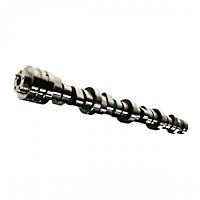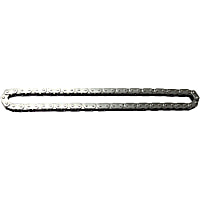The diagnostic trouble code (DTC) P0009 indicates an irregularity regarding the position of the camshaft/s in your engine. What causes this error code to set? What are the symptoms and causes of this code? This informative guide will help you answer these questions and more.
What Does the P0009 Code Mean?
Diagnostic trouble code (DTC) P0009 stands for “Engine Position Performance Bank 2.” The “Bank 2” in this code’s definition refers to the part of the engine that does not contain the cylinder number 1.
The engine relies on the precise timing of its moving parts so it can function properly. If a component falls out of rhythm, it can cause problems that may damage the engine permanently. If the pistons and valves of an engine, for example, are mistimed, they can collide, causing extensive damage.

To ensure that the pistons and valves are timed properly, the camshaft and the crankshaft must also be properly synchronized. Timing belts or chains connect the camshaft and the crankshaft.
The camshaft is equipped with a camshaft position sensor (CMP). Likewise, the crankshaft also has a similar sensor called the crankshaft position sensor (CKP).
The PCM uses the information gathered by the CMP sensors to monitor the position and speed of the camshaft/s. The PCM then compares this information with that of the CKP sensor to ensure that the engine is timed properly. The P0009 trouble code sets when your vehicle’s computer (called the powertrain control module or the PCM) detects that there is a difference in the position of the camshaft in relation to the crankshaft.
Since V engines have timing chains and multiple camshafts, it’s possible for one bank to be out of time with the other bank and with the crankshaft. That’s what code P0009 basically addresses.
When the ECM/PCM detects any out-of-time situation regarding the crankshaft and camshaft (greater than 9 degrees on a GM) and sets a P00xx code, technicians will use an oscilloscope to examine the crank and cam sensor pattern the ECM/PCM is reading while the engine is running.

On GM vehicles, code P0009 can be the result of a crankshaft reluctor that may have moved so that it is improperly indexed. GM Service Bulletin #PIP3423P addresses that in regard to this code as well as P0016 P0017 P0018 P0019 P0008 codes.
You can learn more about how codes like P0009 are logged in our technical discussion about the camshaft and crankshaft.
Note: P0009 code definition may vary depending on the vehicle’s manufacturer. It’s recommended that you consult a repair manual or database for more information.
What are the Possible Causes of the P0009 Code?
The P0009 DTC has a handful of possible causes, the most probable of which are listed below. Note that during diagnosis, it is important to pinpoint the exact root cause in order to come up with an effective and long-term solution.
- Camshaft variable valve timing solenoid failure
- Engine oil level is too low
- Engine not timing correctly
- Engine oil doesn’t meet the manufacturer’s requirements
- Variable valve timing actuator failure
- Worn timing chain or timing belt
- Failed timing chain tensioner or guides
- Damaged or shifted crankshaft reluctor wheel

What are the Common Symptoms of the P0009 Code?
Below are some of the most common symptoms of the P0009 code. If you experience a combination of these, it is advised that you consult a repair manual or database to check for more information.
- Check engine light on
- Decreased engine performance
- Rough running engine
- Hard/extended start
- No start condition
- Increased fuel consumption
- Timing chain rattling noise
- No noticeable adverse conditions in some cases
How to Diagnose the P0009 Code
A proper diagnosis of any OBD-II code starts with an accurate diagnosis. Determining the exact root cause of the issue is the key first step. However, this may pose a challenge since, for most OBD-II codes, there are several possible causes.
If you’re a seasoned DIYer, you may refer to a reliable repair guide or database for more information on the OBD-II codes you’re encountering. These sources have detailed instructions, clear guides, and diagrams. Aside from these sources, you can also consult other resources and materials online.

How to Fix the P0009 Code
As mentioned above, an accurate diagnosis is important in order to reach an effective solution for OBD-II codes. However, vehicles have different configurations, OBD-II code definitions, and troubleshooting procedures. This means that you have to have a trusted and vehicle-specific repair manual at your disposal.
Getting a repair manual or subscribing to a repair database is a good option, especially if you plan to do most vehicle repairs on your own. However, it is advised that you have your vehicle serviced by a professional mechanic or technician immediately if you’re unsure of your repair skills.
Other Notes About P0009
People encounter P0009 more often in GM vehicles. Replacing the timing chain and related components is a common fix. For other GM vehicles, there are technical service bulletins (TSBs) that recommend replacing the crankshaft due to an irregular reluctor wheel. Regardless of the root issue, the general tip to avoid this trouble code is to always use the manufacturer-approved motor oil and change the motor oil at the recommended service intervals.
The P0009 trouble code has high repair importance and difficulty. The code indicates performance and drivability issues such as hard starting or rough running may be present. In some cases, you may be unable to drive your vehicle.
Most often, this code sets along with P0008. Other related codes include P0016, P0017, P0018, and P0019.
Where to Get Engine Parts for Your Ride
Faulty engine parts can make it hard to drive your vehicle, so don’t delay replacing them. If you need a new timing chain or any other parts mentioned above, you can find what you need here at CarParts.com.
Why go to several brick-and-mortar stores to find the engine part you need when you can order it online with just a few clicks at CarParts.com? All you have to do is use our built-in vehicle selector to narrow down your search to the parts that fit your make and model. Then, use the search filters to find the ones that match your preferred brand, price, and features.
Our team of industry experts handpicks all our products to ensure you only choose from tough and reliable parts. On top of that, you don’t need to worry about breaking the bank because all our engine parts are available at unbeatable prices. If you have questions about your order, we have a round-the-clock customer service team ready to assist you.
Shop for premium engine parts now to clear this trouble code in no time!
Product Mentioned in this Guide
Any information provided on this Website is for informational purposes only and is not intended to replace consultation with a professional mechanic. The accuracy and timeliness of the information may change from the time of publication.


 Camshaft
Camshaft
 Camshaft Position Sensor
Camshaft Position Sensor
 Crankshaft Position Sensor
Crankshaft Position Sensor
 Timing Chain
Timing Chain
 Timing Belt
Timing Belt
 Timing Chain Tensioner
Timing Chain Tensioner
















